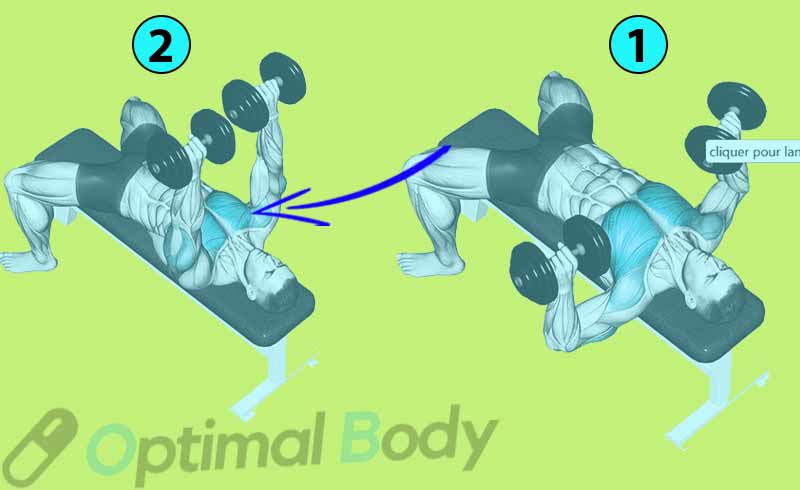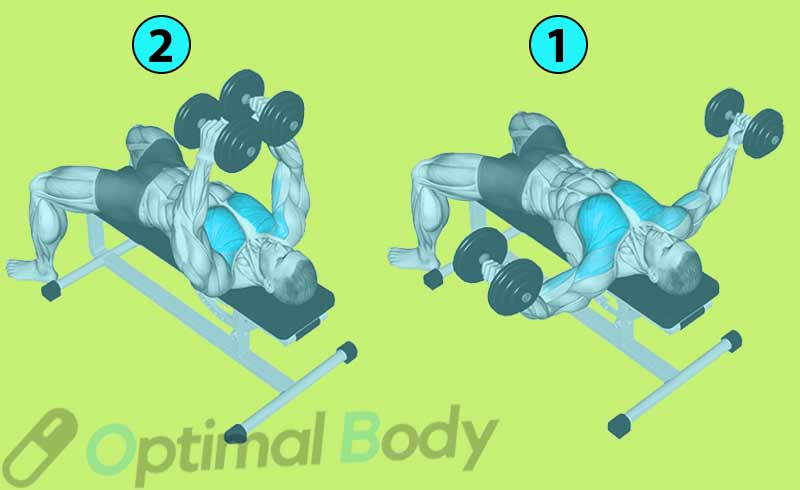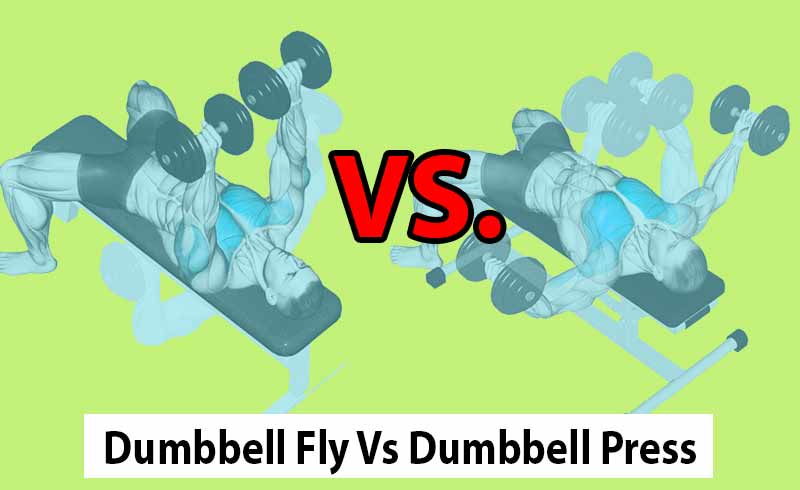Welcome to another informative guide brought to you by optimalbodypill.com.
We’re about to dive into a topic that many gym goers like, whether you want to focus on chest presses or chest flies for building a stronger, more defined chest.
In this exercise comparison, we’ll break down the differences between Dumbbell Fly Vs Dumbbell Press in terms of:
- Muscles worked
- Benefits and drawback
- Which is Better for strength
- Which is better for building chest muscles
- Which is better for isolation
- Can they be Combined
- Exercise variety
- Ease of use
- Best one overall
Before we dive into the specifics, let’s briefly explain what are the Dumbbell Fly and Dumbbell Press:
What Is The Dumbbell Press:

This classic exercise involves lying on a bench and pressing dumbbells vertically, engaging primarily the chest muscles. Alongside the chest, the triceps and anterior deltoids also play supporting roles in this movement.
Alternative Exercise: How To Bench Press Using A Smith Machine?
What Is The Dumbbell Fly:

The Fly, on the other hand, is characterized by a horizontal arm movement. Lying on a bench, you open your arms wide, then bring them back together. This exercise emphasizes the stretch and contraction of the chest muscles.
Alternative Workout: How To Perform Pec Flye Machine For Bigger Chest?
Dumbbell Fly Vs Dumbbell Press: The Key Differences
Muscles Worked
Dumbbell Fly: During this exercise, you’ll feel a strong stretch in your chest muscles as you open your arms wide. This primarily targets your “pecs” the large muscles in your chest.
Additionally, your front shoulders are involved in stabilizing the movement.
Dumbbell Press: This primarily works your chest muscles (pectoralis major) but also engages your triceps and front shoulder muscles (anterior deltoids).
Benefits and Drawbacks
Dumbbell Fly Benefits:
As you bring the dumbbells together in a controlled motion, you experience a satisfying squeeze in your chest, this is due to the fact that flies focus on the abduction of your elbows, creating better tension in the pectoral muscles.
Here are the main advatages that you should know:
- Focused Muscle Contraction: The Dumbbell Fly shines in its ability to provide a unique chest contraction. As you open your arms wide, the pectoral muscles stretch, followed by a controlled squeeze during the closing phase. This can lead to enhanced muscle isolation and hypertrophy.
- Better chest aesthetics: By emphasizing the stretching motion of the chest muscles, the fly helps improve the muscle’s flexibility and enhances the chest’s aesthetic appeal by working on its outer part. This can contribute to a more rounded chest appearance.
- Varying Muscle Stimulation: The Fly’s wider arm movement shifts the emphasis toward the inner part of the chest. If you’re looking to target specific areas of your chest, the Fly might be a valuable addition to your routine.
Dumbbell Chest Fly Drawbacks:
Firstly, as you lift the weights higher, the effectiveness of the exercise diminishes, which isn’t ideal for comprehensive chest growth.
Additionally, performing chest flys can potentially strain your shoulder joints.
The Flys can potentially cause overstretching of the pectoral muscles, particularly if executed with improper form or excessive weight. This puts unnecessary strain on the shoulders and can lead to discomfort or injury.
Dumbbell Press Benefits:
The press is a compound movement that offers a more balanced approach. It targets the overall chest while also engaging the triceps and shoulders.
Here are its advantages:
- Progressive Overload: One of the significant advantages of the Dumbbell Presses is it allows for progressive overload.
The pressing motion allows you to handle heavier weights, contributing to strength gains and muscle growth over time.
It allows you to load up more weight due to the biomechanics involved. Your arms are positioned at a 90-degree angle, providing a solid base for pushing heavier dumbbells. - Comprehensive Muscle Engagement: The Press engages multiple muscle groups, including the chest, triceps, and anterior deltoids.
This compound nature makes it an efficient movement for building upper body strength. - Stable Shoulder Position: Unlike the DB Fly, which can strain the shoulders in certain positions, the Press typically maintains a more stable shoulder alignment.
The DB press reduces the risk of injury, particularly for those with existing shoulder issues.
Chest Press Drawbacks:
However, chest presses aren’t without their drawbacks. Some might argue that they don’t isolate the chest muscles as effectively as other exercises, such as cable flys.
But the benefits of lifting heavier weights outweigh these disadvantages.
Which Is Better For Strength Gains:
Dumbbell Bench Press:
When it comes to building strength, the press takes the lead due to its inclusion of triceps and shoulder muscles.
These secondary muscle groups lead to the ability to lift heavier weights over time.
Better For Building Chest Muscles
Both exercises can effectively build chest muscles. However, the Dumbbell Press might have a slight edge in terms of overall muscle activation since it recruits more muscles.
Best For Isolation
Dumbbell Bench Fly:
This exercise is the better one for isolating the chest muscles. The controlled motion allows you to really focus on contracting and stretching the chest, reducing the involvement of other muscle groups.
Dumbbell Press:
Since it involves more muscle groups, the press is less isolating. However, it’s a great choice when you want to work on multiple upper body muscles simultaneously.
Exercise Variety:
Dumbbell Presses: This exercise can be varied by changing the bench angle (incline, decline, or flat), altering the grip width, or even using different equipment like a barbell or resistance bands.
Dumbbell Flyes: Aside from the traditional version, you can do variations like cable flyes, which maintain constant tension on the chest throughout the movement.
Ease of Use:
Dumbbell Chest Press: This exercise is simpler for most beginners to do. The pressing motion mimics natural movements, making it more intuitive.
Dumbbell Chest Fly: It requires more control to ensure you’re moving through a safe range of motion without straining your shoulder joints. It’s generally better suited for those with a bit more experience.
Dumbbell Press Vs Dumbbell Fly: What Should I Choose?
Choose Dumbbell Press If: Your primary focus is on building overall chest strength and muscle mass. If you value progressive overload and want to minimize the risk of shoulder strain, the Press is your go-to exercise.
Choose Dumbbell Fly If: You have a solid foundation in chest exercises and are looking to add variation to your routine. If you’re seeking a unique muscle contraction and don’t have existing shoulder issues, the Fly could offer a novel challenge.
Can I combine the dumbbell press with dumbbell flyes?
Yes, you can combine them. In fact, combining them intelligently can be quite effective. For example, start your workout routine with Dumbbell Press to build overall strength, and then follow it up with Dumbbell Fly to isolate and further fatigue your chest muscles.
Conclusion: Better Overall
There isn’t a definitive “better” exercise. It depends on your goals.
However, if you’re just starting out or looking to build overall chest strength, Dumbbell Press might be a stronger option.
If you want to target your chest muscles more intensely, Dumbbell Fly could be your focus.
A balanced routine that includes both can yield great results.
References:
- Journal of Strength and Conditioning Research 37(5):p 1135-1144, May 2023. Which ROMs Lead to Rome? A Systematic Review of the Effects of Range of Motion on Muscle Hypertrophy.
- Reiser FC, Lira JLO, Bonfim BMA, Santos Filho SJA, Durante BG, Cardoso JMD, Miotto H, Soares MAA, Bonuzzi GMG, Tavares LD. Electromyography of Dumbbell Fly Exercise Using Different Planes and Labile Surfaces. JEPonline 2017;20(6):31-40
- Saeterbakken AH, van den Tillaar R, Fimland MS. A comparison of muscle activity and 1-RM strength of three chest-press exercises with different stability requirements. J Sports Sci. 2011;29(5):533-538. doi:10.1080/02640414.2010.543916
- Solstad TE, Andersen V, Shaw M, Hoel EM, Vonheim A, Saeterbakken AH. A Comparison of Muscle Activation between Barbell Bench Press and Dumbbell Flyes in Resistance-Trained Males. J Sports Sci Med. 2020;19(4):645-651. Published 2020 Nov 19.
- Bench Press Calculator - April 22, 2024
- Press to Handstand: Ultimate Step-by-Step Guide - April 22, 2024
- Cable Press (How To Do, Benefits, Targeted Muscles, Alternative) - April 22, 2024

